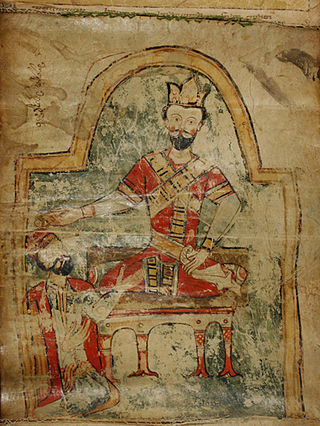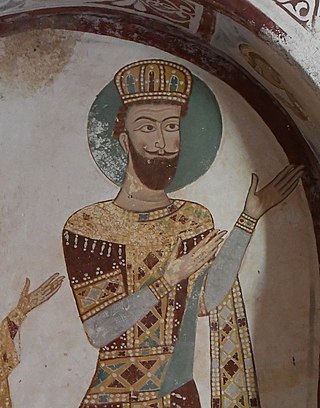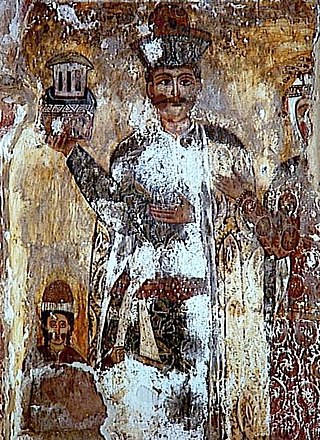Related Research Articles
Bagrat VI, a representative of the Imeretian branch of the Bagrationi dynasty, was a king (mepe) of Imereti from 1463, and a king of Georgia from 1465 until his death.
Vakhtang V, born Bakhuta Mukhranbatoni, was king (mepe) of Kartli from 1658 until his death, who ruled as a vassal wali for the Persian shah. He is also known under the name of Shah Nawaz, which he assumed on being obliged outwardly to conform to Islam.

George VIII of the Bagrationi dynasty, was de facto last king (mepe) of the formerly united Kingdom of Georgia from 1446 to 1465. He would later rule in the Kingdom of Kakheti as George I from 1465 until his death in 1476, founding a local branch of the Bagrationi dynasty.

Alexander II was a king (mepe) of Georgia in 1478 and of Imereti from 1483 to 1510.
Constantine II, of the Bagrationi dynasty, was the 23rd and last king (mepe) of United Georgia from 1478 until his death. Early in the 1490s, he had to recognise the independence of his rival rulers of Imereti and Kakheti, and to confine his power to Kartli. In 1505, Constantine II died, and was succeeded by his son David X.

The Principality of Guria was a historical state in Georgia. Centered on modern-day Guria, a southwestern region in Georgia, it was located between the Black Sea and Lesser Caucasus, and was ruled by a succession of twenty-two princes of the House of Gurieli from the 1460s to 1829. The principality emerged during the process of fragmentation of a unified Kingdom of Georgia. Its boundaries fluctuated in the course of permanent conflicts with neighboring Georgian rulers and the Ottoman Empire, and the principality enjoyed various degrees of autonomy until being annexed by Imperial Russia in 1829.

Bagrat III (1495-1565), of the Bagrationi dynasty, was a king (mepe) of Imereti from April 1, 1510, to 1565. He succeeded upon the death of his father, Alexander II, and faced repeated assaults from the Ottoman Turks as well as the conflicts with his ostensible vassal princes of Mingrelia, Guria, and Abkhazia who were frequently joining the enemy.
Giorgi III Gurieli, of the Georgian House of Gurieli, was Prince of Guria from 1669 to 1684 and King of Imereti from 1681 to 1683. He was energetically involved in civil wars in western Georgian polities, which he sought to bring under his sway. He was killed in battle while trying to recover the lost throne of Imereti.
David of Kakheti was a Choreposcopus of Kakheti, a principality of Eastern Georgia, who ruled from 976 until his death 1010.

Levan I Dadiani was a member of the House of Dadiani and ruler of Odishi, that is, Mingrelia, in western Georgia. He succeeded on the death of his father, Mamia III Dadiani, as eristavi ("duke") of Odishi and ex officio mandaturt-ukhutsesi of Imereti in 1533. Dadiani's break with the king of Imereti brought about his downfall and imprisonment in 1546. He was able to escape and regain his possessions, securing Ottoman support for his independence from Imereti.
Mamia IV Dadiani was Prince of Mingrelia, of the House of Dadiani, from 1573 to 1578 and again from 1582 until his death. He was a younger son of Levan I Dadiani.
Kakhaber II Gurieli, of the House of Gurieli, was eristavi ("duke") of Guria from c. 1469 until his death in 1483.
Mamia I Gurieli, of the House of Gurieli, was Prince of Guria from 1512 until his death in 1534. Succeeding on the death of his father Giorgi I Gurieli, Mamia became involved in the conflict between the two eastern Georgian kingdoms of Kartli and Kakheti in 1520; by force of arms, he compelled David X of Kartli to agree on peace with Levan of Kakheti, his son-in-law. Mamia Gurieli's 1533 campaign, jointly with his namesake Prince of Mingrelia, against the homebase of Circassian pirates ended in a fiasco, with Mamia being captured and ransomed later that year.
Rostom Gurieli, of the House of Gurieli, was Prince of Guria from 1534 until his death in 1564. Alongside his royal suzerain, Bagrat III of Imereti, Rostom fought against the expanding Ottoman Empire to which he lost parts of his principality. Rostom's relations with Bagrat III subsequently deteriorated over his support to the king's defiant vassal, Levan I Dadiani.
Giorgi II Gurieli, of the House of Gurieli, was Prince of Guria from 1564 to 1583 and again from 1587 to 1600. Succeeding on the death of his father Rostom Gurieli, Giorgi's rule over his small principality, located in southwest Georgia, was a period of conflict with the neighboring Dadiani of Mingrelia and increasing assertiveness of the Ottomans whom Gurieli submitted in 1581. His reign was interrupted, from 1583 to 1587, by a Mingrelian invasion, but Giorgi was able to resume the throne with Ottoman support.

Mamia II Gurieli (-1625/1627) is a 17th-century Georgian prince that ruled over the Principality of Guria in Western Georgia. Son of Prince George II, he succeeded his father in 1600 after spending a decade as head of Gurian troops. As Prince, he distinguished himself as a staunch supporter of closer relations with other Georgian states and an enemy of the Ottoman Empire. However, his policy failed as he was forced to remain under Turkish influence, while his ties with the Kingdom of Imereti progressively declined until an armed conflict and his assassination in 1625.
The Battle of Karagak was fought between the armies of the Kingdom of Imereti and the Ottoman Empire at the place of Karagak, Meskheti, in 1543.

The collapse of the Georgian realm was a political and territorial fragmentation process that resulted in the dynastic triumvirate military conflict of the Bagrationi monarchs and war of succession in the united Kingdom of Georgia culminating during the second half of the 15th century.

The Kingdom of Western Georgia was a late medieval de facto independent fragmented part of the Kingdom of Georgia that emerged during the Mongol invasions of the realm, led by King David VI Narin in 1259 and later followed by his successors. During this period, the Kingdom of Georgia (1256–1329) was reduced to the eastern part of the country and placed under Mongol control. Over the decades, the monarchy would fall into chaos and transform into a federation of autonomous principalities unruly of the central or regional royal power and authority.
The Duchy of Samokalako, also known as the Duchy of Imereti or the Duchy of Kutaisi, was a duchy of the Kingdom of Georgia from the 15th century. Created by King Alexander I of Georgia upon the reestablishment of royal control over the Kingdom of Western Georgia, the duchy was given to a cadet branch of the Bagrationi dynasty. However, its history remains short and its secession following the Battle of Chikhori led to the Georgian civil war of 1463–1491.
References
- ↑ Brosset 1858, pp. 207–208.
- 1 2 Salia 1980, p. 265.
- 1 2 Brosset 1858, pp. 249–250.
- ↑ Asatiani 2008, p. 121.
- 1 2 Brosset 1849, p. 646.
- 1 2 Rayfield 2012, p. 160.
- 1 2 Brosset 1858, p. 208.
- 1 2 3 Brosset 1858, p. 250.
- ↑ Asatiani & Janelidze 2009, p. 121.
- ↑ Salia 1980, p. 266.
- ↑ Suny, Ronald Grigor (1994), The Making of the Georgian Nation: 2nd edition. Indiana University Press, ISBN 0-253-20915-3
- ↑ Toumanoff, Cyril (1949–51). The Fifteenth-Century Bagratids and the Institution of Collegial Sovereignty in Georgia. Traditio 7: 192.